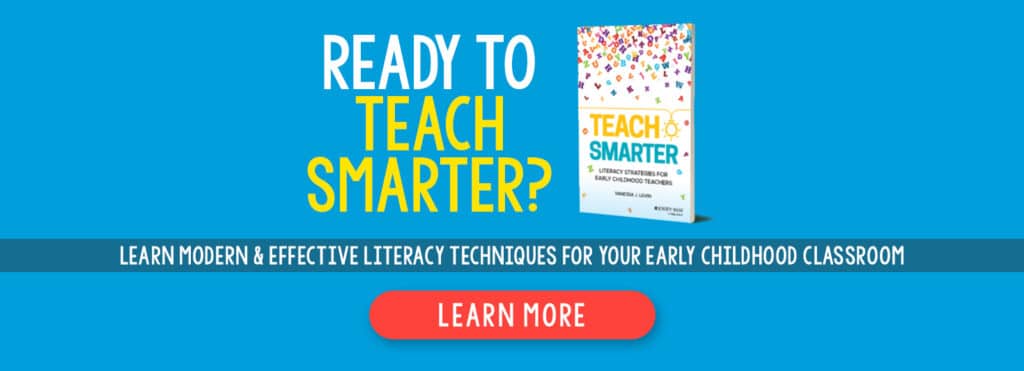Let’s face it, teaching young children to be more independent isn’t easy.
In fact, it’s one of those tasks that takes a lot of patience, hard work, and intention planning.
But today’s your lucky day, because the brilliant Dan St. Romain is here to help break it all down for you.
In last week’s episode of our Behavior Bites series, Dan and I discussed how to decrease interruptions during small group time.
And something Dan and I really focused on during that conversation was the importance of teaching preschool-aged children to be more independent in the classroom.
Today, we’re taking a deep dive into the pitfalls to avoid when working on developing more independence skills.
Listen in as Dan and I discuss the best ways to teach your preschool students to become independent and how to avoid the pitfalls many teachers make when it comes to fostering independence in the early childhood classroom.
All right, let’s dive in!
How to Encourage Your Students to Become More Independent
As teachers and as parents, there are a lot of traps around us that we inadvertently fall into when we try to teach our children to be independent. Without really meaning to, we end up encouraging kids to become more dependent on us instead of the opposite.
And so, one of the best ways to teach young children to be more independent is to look at these practices and traps we fall into, and change them.
What traps are we talking about exactly? Well, that’s coming next, so keep reading!
The Traps You Need to Avoid
The “Do For” Trap
Here is a quick example for you. If a child walks up to you and puts their shoe in your face without saying anything, what would you do?
Many teachers would help the kid put their shoes on without thinking twice about it. But that’s a mistake, because that teaches the kid to be dependent on the adults around them.
When we teachers do things like that, we rob children of the opportunity to work through their own issues and acquire problem solving skills. When we do things for kids, we encourage them to come back to us every time they have an issue.
This is the main trap early childhood education teachers fall into. We don’t always have the time (or patience, let’s be honest) to teach a child how to do something. So we’d rather just do it for them since we’ll be quick. However, by acting like that, we’re doing our students a disservice.
Not doing everything for your students is a small step, but it is one that leads to independence, and it’s worth taking!
The “Do To” Trap
The bigger, more challenging trap is what Dan likes to call the “Do To” trap. This is more difficult to get out of because it’s built in our entire school system.
What do we mean exactly by the “Do To” trap? Simply, using punishments like timeouts or grounding to be in control and pull the strings.
When we get heavy handed with our punishments and our rewards, we take control away from the children.
As early childhood professionals, we need to be very careful not to fall into this trap. Because when we dole out punishments and rewards too much, we tell the kids around us that we are in control, not them.
So, what can you do about this exactly?
Well, rather than punishing and rewarding, talk to the children! Yes, it’s as simple as that (well, not really, but with time it becomes easier). Discussing the problem and working together to find a solution with a child will do them more good than punishing them ever will.
Doing so moves you and the kids away from the “I’m going to solve the problem by doing something to them” mentality and puts the whole thing into a neutral place where you’re going to talk to them and come up with the answer together.
If we want to achieve self-regulation, meaning kids being able to solve problems on their own, then we have to have conversations with them and involve them in the process.
Here’s a quick and easy way to remember this lesson: Do more things with children and less things to children.
Dan and I discuss this subject in more depth and share a few more helpful tips in the episode above. So, if you’d like to know more about teaching kids to become more independent, make sure to tune in now!
Links Mentioned in this Episode:
Learn more about Dan St. Romain

![EEC084_wide [Image: Want More Independent Students? Do This, Not That!]](https://www.pre-kpages.com/wp-content/uploads/2023/02/EEC084_wide-1024x576.png)
![[Image: “There are some things you might be doing that sabotage your students' independence.” - Vanessa Levin]](https://www.pre-kpages.com/wp-content/uploads/2023/02/EEC084_quote1-1024x1024.png)
![[Image quote: “[The best way to help kids to be able to do things on their own] is to build in very specific procedures that allow them to be able to accomplish some tasks on their own.” - Dan St. Romain]](https://www.pre-kpages.com/wp-content/uploads/2023/02/EEC084_quote3-1024x1024.png)
